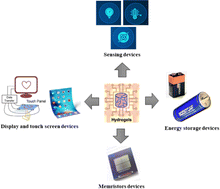Smart materials for flexible electronics and devices: hydrogel
Abstract
In recent years, flexible conductive materials have attracted considerable attention for their potential use in flexible energy storage devices, touch panels, sensors, memristors, and other applications. The outstanding flexibility, electricity, and tunable mechanical properties of hydrogels make them ideal conductive materials for flexible electronic devices. Various synthetic strategies have been developed to produce conductive and environmentally friendly hydrogels for high-performance flexible electronics. In this review, we discuss the state-of-the-art applications of hydrogels in flexible electronics, such as energy storage, touch panels, memristor devices, and sensors like temperature, gas, humidity, chemical, strain, and textile sensors, and the latest synthesis methods of hydrogels. Describe the process of fabricating sensors as well. Finally, we discussed the challenges and future research avenues for flexible and portable electronic devices based on hydrogels.

- This article is part of the themed collection: 2024 Reviews in RSC Advances


 Please wait while we load your content...
Please wait while we load your content...